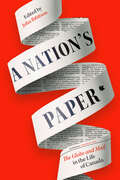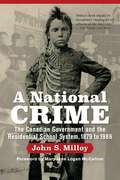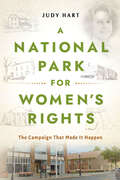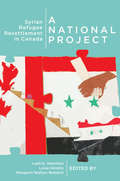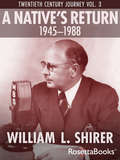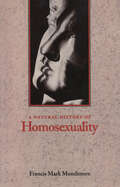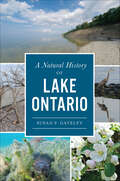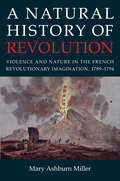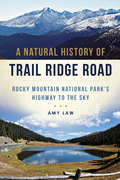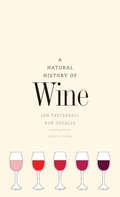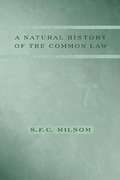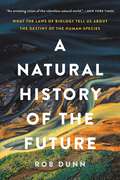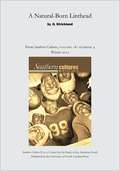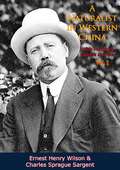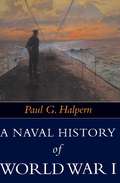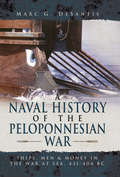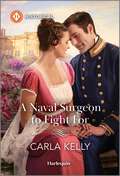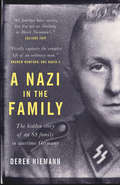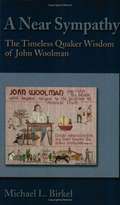- Table View
- List View
A Nation's Paper: The Globe and Mail in the Life of Canada
by John IbbitsonFrom Canada's newspaper of record for 180 years, here are thirty-one brilliant and provocative essays by a diverse selection of their writers on how The Globe and Mail covered and influenced major events and issues from the paper&’s founding to the latest file. Since 1844, the Globe and Mail and its predecessor, George Brown&’s Globe, have chronicled Canada: as a colony, a dominion, and a nation. To mark the paper&’s 180th anniversary, Globe writers explored thirty issues and events in which the national newspaper has influenced the course of the country: Confederation, settler migrations, regional tensions, tussles over language, religion, and race. The essays reveal a tapestry of progress, conflict, and still-incomplete reconciliation: Catholic-Protestant hostilities that are now mostly the stuff of memory; the betrayal of Indigenous peoples with which we still grapple; the frustrations and triumphs of women journalists; pandemics old and new; environmental challenges; the joys of covering sports and the arts; chronicling the nation&’s business, international coverage, the impossibility of Canada and of this newspaper, which both somehow flourish nonetheless. Riveting, insightful, disturbing, witty, and always a joy to read, A Nation&’s Paper chronicles a country and a newspaper that have grown and struggled together – essential reading for anyone who wants to understand where we came from and where we are going. The Globe and Mail will donate all its proceeds from the book to Journalists for Human Rights.
A National Crime: The Canadian Government and the Residential School System
by John S. Milloy“I am going to tell you how we are treated. I am always hungry.” — Edward B., a student at Onion Lake School (1923) "[I]f I were appointed by the Dominion Government for the express purpose of spreading tuberculosis, there is nothing finer in existance that the average Indian residential school.” — N. Walker, Indian Affairs Superintendent (1948) For over 100 years, thousands of Aboriginal children passed through the Canadian residential school system. Begun in the 1870s, it was intended, in the words of government officials, to bring these children into the “circle of civilization,” the results, however, were far different. More often, the schools provided an inferior education in an atmosphere of neglect, disease, and often abuse. Using previously unreleased government documents, historian John S. Milloy provides a full picture of the history and reality of the residential school system. He begins by tracing the ideological roots of the system, and follows the paper trail of internal memoranda, reports from field inspectors, and letters of complaint. In the early decades, the system grew without planning or restraint. Despite numerous critical commissions and reports, it persisted into the 1970s, when it transformed itself into a social welfare system without improving conditions for its thousands of wards. A National Crime shows that the residential system was chronically underfunded and often mismanaged, and documents in detail and how this affected the health, education, and well-being of entire generations of Aboriginal children.
A National Crime: The Canadian Government and the Residential School System
by John S. Milloy Mary Jane Mccallum“I am going to tell you how we are treated. I am always hungry.” — Edward B., a student at Onion Lake School (1923) "[I]f I were appointed by the Dominion Government for the express purpose of spreading tuberculosis, there is nothing finer in existance that the average Indian residential school.” — N. Walker, Indian Affairs Superintendent (1948) For over 100 years, thousands of Aboriginal children passed through the Canadian residential school system. Begun in the 1870s, it was intended, in the words of government officials, to bring these children into the “circle of civilization,” the results, however, were far different. More often, the schools provided an inferior education in an atmosphere of neglect, disease, and often abuse. Using previously unreleased government documents, historian John S. Milloy provides a full picture of the history and reality of the residential school system. He begins by tracing the ideological roots of the system, and follows the paper trail of internal memoranda, reports from field inspectors, and letters of complaint. In the early decades, the system grew without planning or restraint. Despite numerous critical commissions and reports, it persisted into the 1970s, when it transformed itself into a social welfare system without improving conditions for its thousands of wards. A National Crime shows that the residential system was chronically underfunded and often mismanaged, and documents in detail and how this affected the health, education, and well-being of entire generations of Aboriginal children.
A National Park for Women's Rights: The Campaign That Made It Happen
by Judy HartA National Park for Women's Rights chronicles a little-known story in American history: the establishment of the Women's Rights National Historical Park in Seneca Falls, New York; the first "idea park" in the National Park system. As told by Judy Hart, its visionary founder and first superintendent, the park's story is one of struggle and perseverance, opposition and solidarity. Hart narrates the uphill battle she fought to secure the park's location—on the site of the first women's rights convention in 1848—and to gain respect for the idea of a park dedicated to women's rights from 1978, when she first championed its creation to the triumphant moment in 1982 when the park opened its doors, and following years. Hart's journey highlights the prejudices and resistance that she faced, like other women who have advocated for themselves, their rights, and their place in America. Going behind the scenes of the park's planning and the negotiations, conflicts, and collaborations that shaped the final vision, A National Park for Women's Rights highlights the contributions of Park Service officials, politicians, and interested citizens in Seneca Falls, despite opposition from within and beyond the Park Service.An inspiration and rallying cry for women (and their male allies) to tell their stories and claim their place in American history, A National Park for Women's Rights also offers a model for public history activism. No matter how daunting the opposition to such acts of historical memory-making are, Hart's experiences remind citizen-activists to dream, organize, and persist.
A National Project: Syrian Refugee Resettlement in Canada (McGill-Queen's Refugee and Forced Migration Studies)
by Leah K. Hamilton, Luisa Veronis, and Margaret Walton-RobertsSince the outbreak of the Syrian Civil War in 2011, over 5.6 million people have fled Syria and another 6.6 million remain internally displaced. By January 2017, a total of 40,081 Syrians had sought refuge across Canada in the largest resettlement event the country has experienced since the Indochina refugee crisis. Breaking new ground in an effort to understand and learn from the Syrian Refugee Resettlement Initiative that Canada launched in 2015, A National Project examines the experiences of refugees, receiving communities, and a range of stakeholders who were involved in their resettlement, including sponsors, service providers, and various local and municipal agencies. The contributors, who represent a wide spectrum of disciplines, include many of Canada's leading immigration scholars and others who worked directly with refugees. Considering the policy behind the program and the geographic and demographic factors affecting it, chapters document mobilization efforts, ethical concerns, integration challenges, and varying responses to resettling Syrian refugees from coast to coast. Articulating key lessons to be learned from Canada's program, this book provides promising strategies for future events of this kind. Showcasing innovative practices and initiatives, A National Project captures a diverse range of experiences surrounding Syrian refugee resettlement in Canada.
A Native Heritage: Images of the Indian in English-Canadian Literature (The Royal Society of Canada Special Publications)
by Leslie MonkmanDisparity and division in religion, technology and ideology have characterized relations between English-Canadian and Indian cultures through-out Canada's history. From the earliest declaration of white territorial ownership to the current debate on aboriginal rights, red man and white man have had opposing principles and perspectives. The most common 'solutions' imposed on these conflicts by white men have relegated the Indian to the fringes of white society and consciousness. This survey of English-Canadian literature is the first comprehensive examination of a tradition in which white writers turn to the Indian and his culture for standards and models by which they can measure their own values and goals; for patterns of cultural destruction, transformation, and survival; and for sources of native heroes and indigenous myths. Leslie Monkman examines images of the Indian as they appear in works raning from Robert Rogers' Ponteach, or The Savages of America (1766) to Robertson Davies' 'Pontiac and the Green Man' (1977), demonstrating how English-Canadian writers have illuminated their own world through reference to Indian culture. The Indian has been seen as an antagonist, as a superior alternative, as a member of a vanishing and lamented race, and as a hero and the source of the new myths. Although white/Indian tension often lies in apparently irreconcilable opposites, Monkman finds in the literature surveyed complementary images reflecting a common humanity.This is an important contribution to a hitherto unexplored area of Canadian literature in English which should give rise to further elaboration of this major theme.
A Native's Return, 1945–1988 (Twentieth Century Journey #3)
by William L. ShirerThe prominent journalist, historian, and author—an eyewitness to some of the most pivotal events of the twentieth century—tells the story of his final years. In the last book of a three-volume series, William L. Shirer recounts his return to Berlin after the Third Reich&’s defeat, his shocking firing by CBS News, and his final visit to Paris sixty years after he first lived there as a cub reporter in the 1920s. It paints a bittersweet picture of his final decades, friends lost to old age, and a changing world. More personal than the first two volumes, this final installment takes an unflinching look at the author&’s own struggles after World War II—and his vindication after the publication of The Rise and Fall of the Third Reich, his most acclaimed work. It also provides intimate details of his often-troubled marriage. This book gives readers a surprising and moving account of the last years of a true historian—and an important witness to history.
A Natural History of Beer
by Ian Tattersall Rob DeSalleA celebration of beer—its science, its history, and its impact on human culture What can beer teach us about biology, history, and the natural world? From ancient Mesopotamian fermentation practices to the resurgent American craft brewery, Rob DeSalle and Ian Tattersall peruse the historical record and traverse the globe for engaging and often surprising stories about beer. They explain how we came to drink beer, what ingredients combine to give beers their distinctive flavors, how beer’s chemistry works at the molecular level, and how various societies have regulated the production and consumption of beer. Drawing from such diverse subject areas as animal behavior, ecology, history, archaeology, chemistry, sociology, law, genetics, physiology, neurobiology, and more, DeSalle and Tattersall entertain and inform with their engaging stories of beer throughout human history and the science behind it all. Readers are invited to grab a beer and explore the fascinating history of its creation.
A Natural History of Homosexuality
by Francis Mark MondimoreSelected by Choice Magazine as an Outstanding Academic TitleA terrible sin, a gift from the gods, a mental illness, a natural human variation—over the centuries people have defined homosexuality in all of these ways. Since the word homosexual was coined in 1869, many scientists in a variety of fields have sought to understand same-sex intimacy. Drawing on recent insights in biology and genetics, psychiatrist Francis Mondimore set out to explore the complex landscape of sexual orientation.The result is A Natural History of Homosexuality, a generous work that synthesizes research in biology, history, psychology, and politics to explain how homosexuality has been understood and defined from ancient times until the present. Mondimore narrates tales of love and courage as well as discrimination and bigotry in settings as diverse as ancient Greece and Victorian England, early America and fin de siecle Vienna. He also tells fascinating stories about societies which accepted, incorporated, or institutionalized homosexuality into mainstream culture, stories illustrating that same-sex eroticism was often accepted as a normal aspect of human sexuality. In twentieth-century America, researchers first recognized that homosexuality might not be "pathological" when Alfred Kinsey and Evelyn Hooker conducted the first studies of sexuality not biased by preconceived notions of "normal" sexual behavior. After exploring sexual development in the human fetus, Mondimore reviews current biological research into the nature of sexual orientation and examines recent scientific findings on the role of heredity and hormones, as well as Simon LeVay's 1991 brain studies. He then turns to a very important focus: on people and their individual experiences. He explores "what happens between childhood and adulthood in an individual that makes him or her come to identify himself or herself as having a sexual orientation." He also explains our current understanding of bisexuality and the transgender phenomena of transsexualism and transvestism. Finally, Mondimore analyzes the circumstances of such prominent scandals as the anti-homosexual trials of Oscar Wilde and Philip von Eulenberg, and recounts the Nazi persecution of homosexuals during the Holocaust. This far-reaching discussion includes a description of the ex-gay ministries and reparative therapy as well as the Stonewall riots and AIDS, ending with the emergence of gay pride and community.
A Natural History of Human Emotions (Books That Changed the World)
by Stuart WaltonA “fresh and entertaining” survey of the human emotional landscape—and how it has shifted over the centuries (Kirkus Reviews). Using Charles Darwin’s survey of emotions as a starting point, Stuart Walton’s A Natural History of Human Emotions examines the history of each of our core emotions—fear, anger, disgust, sadness, jealousy, contempt, shame, embarrassment, surprise, and happiness—and how these emotions have influenced both cultural and social history. We learn that primitive fear served as the engine of religious belief, while a desire for happiness led to humankind’s first musings on achieving a perfect utopia. Challenging the notion that human emotion has remained constant, A Natural History of Human Emotions explains why, in the last 250 years, society has changed its unwritten rules for what can be expressed in public and in private. Like An Intimate History of Humanity and Near a Thousand Tables, Walton’s A Natural History of Human Emotions is a provocative examination of human feelings and a fascinating take on how emotions have shaped our past.
A Natural History of Lake Ontario (Natural History)
by Susan P. GateleyFormed by glaciers more than twelve thousand years ago, Lake Ontario has captivated nature lovers for generations. Unique among the Great Lakes for having once been connected to the sea, fossils from ocean life have been found near the lake's shores. Damage done to Lake Ontario's ecosystem from centuries of human activity was center stage in the fight to pass the Clean Water Act and the restoration that followed. From incredibly diverse bird migrations in the spring and fall to the squalls and lake effect snow in winter, each season offers a rich ecological tapestry. Author Susan P. Gateley charts the natural history of Lake Ontario from its ice age origins to the climate and habitat challenges it faces today.
A Natural History of Revolution: Violence and Nature in the French Revolutionary Imagination, 1789–1794
by Mary Ashburn MillerHow did the French Revolutionaries explain, justify, and understand the extraordinary violence of their revolution? In debating this question, historians have looked to a variety of eighteenth-century sources, from Rousseau’s writings to Old Regime protest tactics. A Natural History of Revolution suggests that it is perhaps on a different shelf of the Enlightenment library that we might find the best clues for understanding the French Revolution: namely, in studies of the natural world. In their attempts to portray and explain the events of the Revolution, political figures, playwrights, and journalists often turned to the book of nature: phenomena such as hailstorms and thunderbolts found their way into festivals, plays, and political speeches as descriptors of revolutionary activity. The particular way that revolutionaries deployed these metaphors drew on notions derived from the natural science of the day about regeneration, purgation, and balance. In examining a series of tropes (earthquakes, lightning, mountains, swamps, and volcanoes) that played an important role in the public language of the Revolution, A Natural History of Revolution reveals that understanding the use of this natural imagery is fundamental to our understanding of the Terror. Eighteenth-century natural histories had demonstrated that in the natural world, apparent disorder could lead to a restored equilibrium, or even regeneration. This logic drawn from the natural world offered the revolutionaries a crucial means of explaining and justifying revolutionary transformation. If thunder could restore balance in the atmosphere, and if volcanic eruptions could create more fertile soil, then so too could episodes of violence and disruption in the political realm be portrayed as necessary for forging a new order in revolutionary France.
A Natural History of Trail Ridge Road: Rocky Mountain National Park's Highway to the Sky (Natural History)
by Amy LawConstructed from 1929 to 1932 and opened to tourists and drivers the following year, Trail Ridge Road earned immediate inclusion among the scenic wonders of the world. The new path through the park followed the ancient trail across Tombstone Ridge and offered visitors breathtaking views and a privileged glimpse at unique ecosystems. Today, Trail Ridge Road endures as a truly otherworldly place. It is the country's highest continuous paved road, peaking at over twelve thousand feet and running forty-eight miles. Join author Amy Law on a tour across the Continental Divide and through the history of Colorado's most famous byway.
A Natural History of Wine
by Ian Tattersall Rob DeSalle&“Wine is art. Wine is ritual. Wine is culture. Wine is romance. But in the hands of Tattersall and DeSalle . . . we learn that wine is also science.&”—Neil deGrasse Tyson A Wall Street Journal Best Book for Wine Lovers An excellent bottle of wine can be the spark that inspires a brainstorming session. Such was the case for Ian Tattersall and Rob DeSalle, scientists who frequently collaborate on book and museum exhibition projects. When the conversation turned to wine one evening, it almost inevitably led the two—one a palaeoanthropologist, the other a molecular biologist—to begin exploring the many intersections between science and wine. This book presents their fascinating, freewheeling answers to the question &“What can science tell us about wine?&” And vice versa. Conversational and accessible to everyone, this colorfully illustrated book embraces almost every imaginable area of the sciences, from microbiology and ecology (for an understanding of what creates this complex beverage) to physiology and neurobiology (for insight into the effects of wine on the mind and body). The authors draw on physics, chemistry, biochemistry, evolution, and climatology, and they expand the discussion to include insights from anthropology, primatology, entomology, Neolithic archaeology, and even classical history. The resulting volume is indispensable for anyone who wishes to appreciate wine to its fullest. &“Chemistry. Evolutionary biology. Genetics. This book is an excellent layman&’s refresher on these diverse topics, and many more, and how they fit into the grand scheme of wine . . . A fact-packed and accessible read that goes a long way toward explaining why and how wine became such an important component in our enjoyment of the natural world.&”—Wine Spectator
A Natural History of the Common Law (James S. Carpentier Lectures)
by S. F. MilsomHow does law come to be stated as substantive rules, and then how does it change? In this collection of discussions from the James S. Carpentier Lectures in legal history and criticism, one of Britain's most acclaimed legal historians S. F. C. Milsom focuses on the development of English common law—the intellectually coherent system of substantive rules that courts bring to bear on the particular facts of individual cases—from which American law was to grow. Milsom discusses the differences between the development of land law and that of other kinds of law and, in the latter case, how procedural changes allowed substantive rules first to be stated and then to be circumvented. He examines the invisibility of early legal change and how adjustment to conditions was hidden behind such things as the changing meaning of words. Milsom points out that legal history may be more prone than other kinds of history to serious anachronism. Nobody ever states his assumptions, and a legal writer, addressing his contemporaries, never provided a glossary to warn future historians against attributing their own meanings to his words and therefore their own assumptions to his world. Formal continuity has enabled nineteenth-century assumptions to be carried back, in some respects as far back as the twelfth century. This book brings together Milsom's efforts to understand the uncomfortable changes that lie beneath that comforting formal surface. Those changes were too large to have been intended by anyone at the time and too slow to be perceived by historians working within the short periods now imposed by historical convention. The law was made not by great men making great decisions but by man-sized men unconcerned with the future and thinking only about their own immediate everyday difficulties. King Henry II, for example, did not intend the changes attributed to him in either land law or criminal law; the draftsman of De Donis did not mean to create the entail; nobody ever dreamed up a fiction with intent to change the law.
A Natural History of the Future: What the Laws of Biology Tell Us about the Destiny of the Human Species
by Rob DunnA leading ecologist argues that if humankind is to survive on a fragile planet, we must understand and obey its iron lawsOur species has amassed unprecedented knowledge of nature, which we have tried to use to seize control of life and bend the planet to our will. In A Natural History of the Future, biologist Rob Dunn argues that such efforts are futile. We may see ourselves as life&’s overlords, but we are instead at its mercy. In the evolution of antibiotic resistance, the power of natural selection to create biodiversity, and even the surprising life of the London Underground, Dunn finds laws of life that no human activity can annul. When we create artificial islands of crops, dump toxic waste, or build communities, we provide new materials for old laws to shape. Life&’s future flourishing is not in question. Ours is.As ambitious as Edward Wilson&’s Sociobiology and as timely as Elizabeth Kolbert&’s The Sixth Extinction, A Natural History of the Future sets a new standard for understanding the diversity and destiny of life itself.
A Natural History of the Piano: The Instrument, the Music, the Musicians from Mozart to Modern Jazz and Everything in Between
by Stuart IsacoffA beautifully illustrated, totally engrossing celebration of the piano, and the composers and performers who have made it their own. With honed sensitivity and unquestioned expertise, Stuart Isacoff--pianist, critic, teacher, and author of Temperament: How Music Became a Battleground for the Great Minds of Western Civilization--unfolds the ongoing history and evolution of the piano and all its myriad wonders: how its very sound provides the basis for emotional expression and individual style, and why it has so powerfully entertained generation upon generation of listeners. He illuminates the groundbreaking music of Mozart, Beethoven, Liszt, Schumann, and Debussy. He analyzes the breathtaking techniques of Glenn Gould, Oscar Peterson, Vladimir Ashkenazy, Arthur Rubinstein, and Van Cliburn, and he gives musicians including Alfred Brendel, Murray Perahia, Menahem Pressler, and Vladimir Horowitz the opportunity to discuss their approaches. Isacoff delineates how classical music and jazz influenced each other as the uniquely American art form progressed from ragtime, novelty, stride, boogie, bebop, and beyond, through Scott Joplin, Fats Waller, Duke Ellington, Bill Evans, Thelonious Monk, Chick Corea, Herbie Hancock, Cecil Taylor, and Bill Charlap. A Natural History of the Piano distills a lifetime of research and passion into one brilliant narrative. We witness Mozart unveiling his monumental concertos in Vienna's coffeehouses, using a special piano with one keyboard for the hands and another for the feet; European virtuoso Henri Herz entertaining rowdy miners during the California gold rush; Beethoven at his piano, conjuring healing angels to console a grieving mother who had lost her child; Liszt fainting in the arms of a page turner to spark an entire hall into hysterics. Here is the instrument in all its complexity and beauty. We learn of the incredible craftsmanship of a modern Steinway, the peculiarity of specialty pianos built for the Victorian household, the continuing innovation in keyboards including electronic ones. And most of all, we hear the music of the masters, from centuries ago and in our own age, brilliantly evoked and as marvelous as its most recent performance. With this wide-ranging volume, Isacoff gives us a must-have for music lovers, pianists, and the armchair musician.From the Hardcover edition.
A Natural-Born Linthead
by Jl StricklandI would stand outside the mill fence mesmerized by the shadows of pumping Jacquard loom arms on the opaque windowpanes. I had found where I wanted to go. It looked like fun to me. It looked like magic. It didn't take long for that silly notion to be knocked out of my head. But, I persevered and, as the years passed, lint became my life."This article appears in the Winter 2012 issue of Southern Cultures. The full issue is also available as an ebook.Southern Cultures is published quarterly (spring, summer, fall, winter) by the University of North Carolina Press. The journal is sponsored by the University of North Carolina at Chapel Hill's Center for the Study of the American South.
A Naturalist in Western China With Vasculum, Camera and Gun Vol. I (A Naturalist in Western China With Vasculum, Camera and Gun #1)
by Ernest Henry Wilson Charles Sprague SargentFrom his years of work in Western China in the early 1900s, Ernest Henry Wilson introduced numerous new plants to the gardens of Europe and North America. In this book the author describes expeditions on behalf of the famous nursery of Veitch & Sons to find and collect seeds, bulbs, plants and also herbarium material for Kew Gardens. He paints a vivid picture of the natural history of the region and of the culture and customs of the people.-Print ed.
A Naturalist in Western China With Vasculum, Camera and Gun Vol. II (A Naturalist in Western China With Vasculum, Camera and Gun #2)
by Ernest Henry Wilson Charles Sprague SargentFrom his years of work in Western China in the early 1900s, Ernest Henry Wilson introduced numerous new plants to the gardens of Europe and North America. In this book the author describes expeditions on behalf of the famous nursery of Veitch & Sons to find and collect seeds, bulbs, plants and also herbarium material for Kew Gardens. He paints a vivid picture of the natural history of the region and of the culture and customs of the people.-Print ed.
A Naval History of World War I
by Paul G. HalpernThere have been a number of studies published on the activities of British and German navies during World War I, but little on naval action in other arenas. This book offers for the first time a balanced history of the naval war as a whole, viewed from the perspective of all participants in all major theaters. The author's earlier examination The Naval War in the Mediterranean, 1914-1918, centered on submarine activities and allied efforts to counteract this new menace. With this welcome sequel he again takes the reader beyond those World War I operations staged on the North Sea. Halpern's clear and authoritative voice lends a cohesiveness to this encompassing view of the Italians and Austrians in the Adriatic; the Russians, Germans, and Turks in the Baltic and Black Seas; and French and British in the Mediterranean.Important riverine engagements--notably on the Danube--also are included, along with major colonial campaigns such as Mesopotamia and the Dardanelles. The role of neutral sea powers, such as the Swedes in the Baltic and the Dutch in the East Indies, is examined from the perspective of how their neutrality affected naval activity. Also discussed is the part played by the U.S. Navy and the often overlooked, but far from negligible, role of the Japanese navy. The latter is viewed in the context of the opening months of the war and in the Mediterranean during the height of the submarine crisis of 1917
A Naval History of the Peloponnesian War: Ships, Men and Money in the War at Sea, 431-404 BC
by Marc G. de SantisNaval power played a vital role in the Peloponnesian War. The conflict pitted Athens against a powerful coalition including the preeminent land power of the day, Sparta. Only Athens superior fleet, her wooden walls, by protecting her vital supply routes allowed her to survive. It also allowed the strategic freedom of movement to strike back where she chose, most famously at Sphacteria, where a Spartan force was cut off and forced to surrender.Athens initial tactical superiority was demonstrated at the Battle of Chalcis, where her ships literally ran rings round the opposition but this gap closed as her enemies adapted. The great amphibious expedition to Sicily was a watershed, a strategic blunder compounded by tactical errors which brought defeat and irreplaceable losses. Although Athens continued to win victories at sea, at Arginusae for example, her naval strength had been severely weakened while the Spartans built up their fleets with Persian subsidies. It was another naval defeat, at Aegispotomi (405 BC) that finally sealed Athens fate. Marc De Santis narrates these stirring events while analyzing the technical, tactical and strategic aspects of the war at sea.
A Naval Surgeon to Fight For
by Carla KellyBestselling author Carla Kelly&’s Regency seriesThe Channel Fleet continues, and the life-and-death stakes couldn&’t be higher for this dashing naval hero!Return to her respectable life…Or take a scandalous path to marriage? As her snobbish aunt&’s companion, penniless vicar&’s daughter Jerusha Langley is sent to take a donation to the local naval hospital. There she meets dashing surgeon Jamie Wilson and embarks on a secret mission—sneaking out to help him care for injured sailors! With his life in peril fighting Napoleon, Jamie has never considered taking a wife, yet he&’s impressed by Jerusha&’s nursing ability—and beauty inside and out. Jamie knows she&’s risking a scandal by helping him. Can he risk his heart and save her reputation with a marriage offer? From Harlequin Historical: Your romantic escape to the past.
A Nazi in the Family: The hidden story of an SS family in wartime Germany
by Derek NiemannWARTIME BERLIN: The Niemann family - Karl, Minna and their four children - live in a quiet, suburban enclave. Every day Karl commutes to work, a business manager travelling around inspecting his “factories”. In the evenings he returns home to life as a normal family man.Three years ago Derek Niemann, born and raised in Scotland, made the chilling discovery that his grandfather Karl had been an officer in the SS - and that his “business” used thousands of slave labourers in concentration camps, such as Auschwitz, Dachau, Buchenwald and Sachsenhausen. Derek had known little about the German side of his family, but now a lifetime of unsettling hints and clues began to fall into place.With the help of surviving relatives and hundreds of previously unknown family photographs, Derek uncovers the true story of what Karl did. A Nazi in the Family is an illuminating portrayal of how ordinary people can fall into the service of a monstrous regime.
A Near Sympathy: The Timeless Quaker Wisdom of John Woolman
by Michael BirkelExplores the spiritual life and social teachings of an 18th century Quaker who was influential in early antislavery work.
